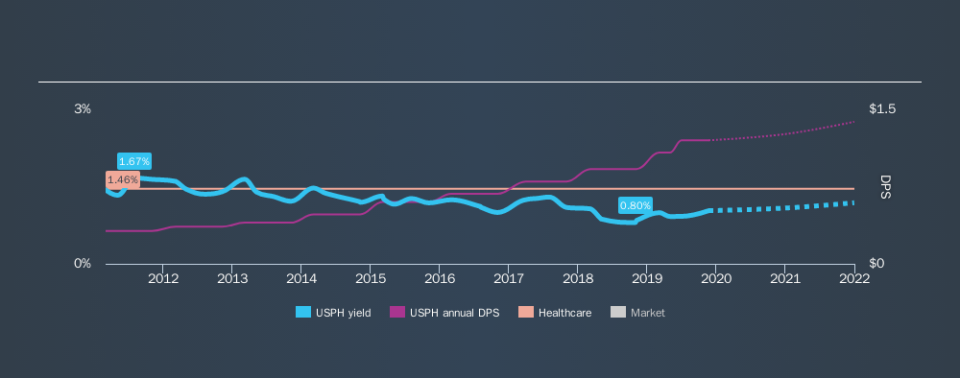Why Dividend Hunters Love U.S. Physical Therapy, Inc. (NYSE:USPH)

Is U.S. Physical Therapy, Inc. (NYSE:USPH) a good dividend stock? How can we tell? Dividend paying companies with growing earnings can be highly rewarding in the long term. Yet sometimes, investors buy a popular dividend stock because of its yield, and then lose money if the company's dividend doesn't live up to expectations.
Investors might not know much about U.S. Physical Therapy's dividend prospects, even though it has been paying dividends for the last nine years and offers a 1.0% yield. A 1.0% yield is not inspiring, but the longer payment history has some appeal. Some simple analysis can reduce the risk of holding U.S. Physical Therapy for its dividend, and we'll focus on the most important aspects below.
Explore this interactive chart for our latest analysis on U.S. Physical Therapy!
Payout ratios
Companies (usually) pay dividends out of their earnings. If a company is paying more than it earns, the dividend might have to be cut. Comparing dividend payments to a company's net profit after tax is a simple way of reality-checking whether a dividend is sustainable. In the last year, U.S. Physical Therapy paid out 46% of its profit as dividends. This is a middling range that strikes a nice balance between paying dividends to shareholders, and retaining enough earnings to invest in future growth. Plus, there is room to increase the payout ratio over time.
Another important check we do is to see if the free cash flow generated is sufficient to pay the dividend. U.S. Physical Therapy's cash payout ratio last year was 24%. Cash flows are typically lumpy, but this looks like an appropriately conservative payout. It's positive to see that U.S. Physical Therapy's dividend is covered by both profits and cash flow, since this is generally a sign that the dividend is sustainable, and a lower payout ratio usually suggests a greater margin of safety before the dividend gets cut.
We update our data on U.S. Physical Therapy every 24 hours, so you can always get our latest analysis of its financial health, here.
Dividend Volatility
One of the major risks of relying on dividend income, is the potential for a company to struggle financially and cut its dividend. Not only is your income cut, but the value of your investment declines as well - nasty. Looking at the last decade of data, we can see that U.S. Physical Therapy paid its first dividend at least nine years ago. Its dividend has not fluctuated much that time, which we like, but we're conscious that the company might not yet have a track record of maintaining dividends in all economic conditions. During the past nine-year period, the first annual payment was US$0.32 in 2010, compared to US$1.20 last year. This works out to be a compound annual growth rate (CAGR) of approximately 16% a year over that time.
U.S. Physical Therapy has been growing its dividend quite rapidly, which is exciting. However, the short payment history makes us question whether this performance will persist across a full market cycle.
Dividend Growth Potential
While dividend payments have been relatively reliable, it would also be nice if earnings per share (EPS) were growing, as this is essential to maintaining the dividend's purchasing power over the long term. U.S. Physical Therapy has grown its earnings per share at 9.7% per annum over the past five years. Earnings per share have been growing at a credible rate. What's more, the payout ratio is reasonable and provides some protection to the dividend, or even the potential to increase it.
Conclusion
To summarise, shareholders should always check that U.S. Physical Therapy's dividends are affordable, that its dividend payments are relatively stable, and that it has decent prospects for growing its earnings and dividend. Firstly, we like that U.S. Physical Therapy has low and conservative payout ratios. We were also glad to see it growing earnings, although its dividend history is not as long as we'd like. All things considered, U.S. Physical Therapy looks like a strong prospect. At the right valuation, it could be something special.
Earnings growth generally bodes well for the future value of company dividend payments. See if the 6 U.S. Physical Therapy analysts we track are forecasting continued growth with our free report on analyst estimates for the company.
Looking for more high-yielding dividend ideas? Try our curated list of dividend stocks with a yield above 3%.
If you spot an error that warrants correction, please contact the editor at editorial-team@simplywallst.com. This article by Simply Wall St is general in nature. It does not constitute a recommendation to buy or sell any stock, and does not take account of your objectives, or your financial situation. Simply Wall St has no position in the stocks mentioned.
We aim to bring you long-term focused research analysis driven by fundamental data. Note that our analysis may not factor in the latest price-sensitive company announcements or qualitative material. Thank you for reading.

 Yahoo Finance
Yahoo Finance 
